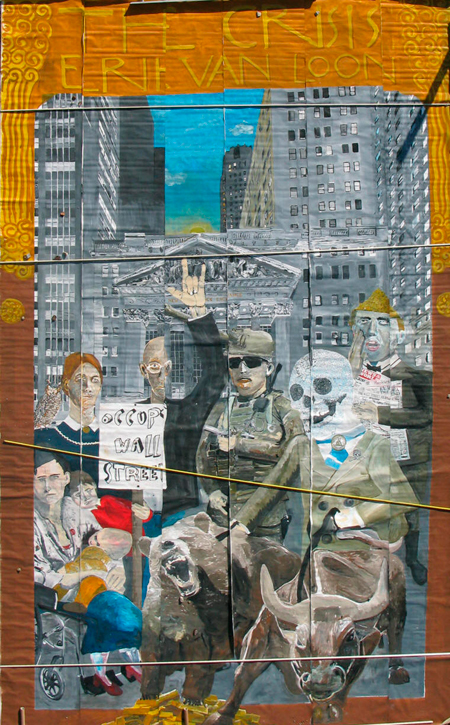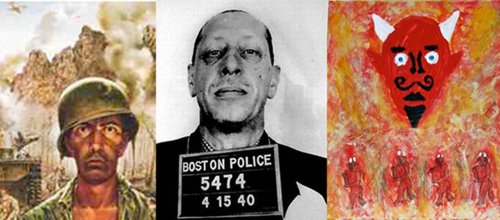The Artist as Worker
 Wednesday, November 9, 2011 at 09:27AM
Wednesday, November 9, 2011 at 09:27AM By Lisa A. Miles
The scare and struggle surrounding a person’s livelihood has suddenly become common denominator in this country. Workers simple and schooled, both with equal pride, have faced significant questions about the integrity of their professions, let alone the viability of their chosen occupations. Auto workers and bankers looked for signs last year– newfound public appreciation or government help spurring sales, confidence in the market, or perhaps literally the blinking exit to another arena to save face.
One group of professionals has continually weathered this storm, however. The nation’s artists. As to whether it makes it any easier to ride out, when many are now suffering, remains to be seen. But due to their strong sense of identity (and the fact that they are used to being poor) they will come out the other end intact– more than can be said of other occupations.
Artists as workers is a concept still un-embraced, despite FDR’s inclusionary attempts with the Works Progress Administration of the 1930s. Artists almost flourished for a small time then. Notice the talk is of artists, here– not so much art organizations. (Much could be written, with artist testimony, on the questionable support of arts organizations to this nation’s actual individual artists.) This definition includes but is not limited to musicians, theatre artists, filmmakers, painters, writers, sculptors, poets, dancers, storytellers, photographers, composers, performers and illustrators (and especially the independent ones, creating new, not derivative, work).
Like the nation’s newly unemployed or underemployed, creative artists are constantly searching for work, looking for viable opportunities for their skills, remaking their roles to fit current needs, and struggling to make ends meet.
Some of the more successful artists are simply blessed with being more resilient and lucky. All those with genuine talent, though, and with an accumulated body of work (albeit little money) have an integrity that can not be swayed externally from their already fragile position. All deserve a better lasting situation in our American society.
The most visible products to come out of the WPA were the bridges and public park structures that many Americans are familiar with, so much in evidence still to this day. But the WPA had many subdivisions, one of which was the Public Works of Art Project, or Federal Arts Project. Its subdivisions were the Theatre Project, the Writers Project, and the Mural and Easel Projects. Produced in cities all across America were new works for the stage, writing both creative and to chronicle, and easel paintings, lithographic prints, posters, watercolors, murals and sculpture, plus more.
Works were made for and distributed to public schools, libraries, planetariums, city and county buildings, housing authorities, garden markets, post offices, park structures, and other tax-supported institutions. It was indeed a ‘shovel-ready’ project (or rather brush and pen) that utilized talent to meet need. Governing bodies other than the WPA partially funded the work. City and state governments and colleges were on board with the creative-economic collaboration. Private recipients included hotels, homes for the elderly and banks.
Associated with the Federal Art Project were the Museum Extension Projects, which employed (as described by program material of the time) “research-workers, draftsmen, artists, sculptors, photographers, model-makers, and other men and women from the professional and technical groups.” Just a bit of material produced: “models of historic locomotives, frontier forts, historic buildings and mankind’s homes the world over, all built from scale drawings based on authentic research; plastic replicas of fruits and vegetables, reptiles, and topographic relief maps; costume color-plates; dioramas; and puppets and puppet play scripts and properties.”
The major uses of the products were as instructional aids, but also for cultural and beautification purpose, with so many public and even private institutions benefitting. Early American reproduction items were produced, to be included in both the Index of American Design and a book on Americana sponsored by the Library of Congress. Historical societies employed writers’ summary essays, as well as theatre artists’ conveyances, of items cataloged in their collections. The value of such vast creative output was deemed a necessity in the realm of public education and cultural betterment for all of society.
Though likely much of the work produced for schools hasn’t survived the touch of youth, time itself hasn’t dimmed direct evidence that the WPA’s Art Project positively affected our nation. Arts project output can be witnessed in natural history museum collections display, and in murals and canvas still visible in public structures of every city– nostalgic momentos of a brief time when public policy actually addressed artists’ dire need for work.
The Great Depression was devastating to most people, and yet ironically, creative artists found themselves considered for the first time with their inclusion in President Roosevelt’s project linking viable work with skillful individuals in need. The economic downslide actually helped– for once, a means by which creative workers could earn a living with their abilities!
FDR’s programs were intended to give not a handout, but an opportunity (previously unconsidered) to employ workers. Homer St. Gaudens, director of the Carnegie Museum of Art, wrote in 1941 that the previous decade was one in which approx. 4,000 artists “were certainly in the submerged social strata. There was appropriated [with the WPA] a sizable sum with which artists, 90% of whom were to be on relief rolls, were [instead] employed at wages of from $69 to $103 a month.” (The American Artist and His Times, NY: Dodd, Mead & Co.)
Artists not only earned money for their basic livelihood, but gained a new sense of outward respect. Through the ages, they have either embraced self-worth or risked insanity. Now at least in the U.S. government’s eyes, artistic ability was finally seen as a viable part of society. Un-legislated individual viewpoints would prove much harder to change.
Former NEA Chair Jane Alexander spoke last year in support of the arts’ inclusion in President Obama’s economic stimulus package, on the heels of protestation by Lousiana Governor Jindal and others deriding what they did not want to understand. She of course well knew the increased stigmatization of the arts that took place in modern-day America at the time of Reagan’s de-funding of the NEA. Her words were significant, stressing the need and value of the country’s artistic output. For though FDR was mindful of the economic suffering of artists in addition to blue-collar workers, possibly enabling the general public to better understand their plight, any public good will would be soon enough squashed (as the Federal Arts Program would hit political pressure and the economy bowed to war).
The opportunity now in 2010, as we pull ourselves out of the Great Recession, is for the work of artists to take a new place in the economy. Discussing the benefits of WPA-like support for creative workers is called for. As well, when business and industry pick themselves up and dust off, they will need to take on Edgar J. Kaufmann’s courageous call for art in commerce. He who utilized art’s beautification in his Pittsburgh department stores, as well as commissioned Frank Lloyd Wright to build the masterpiece Fallingwater home, put out a call to muralists in a 1930 store pamphlet, and noted, “the fact that today we are the richest of nations places on us the added responsibility of giving greater momentum to cultural development than it has ever received from any people. Business and industry must accept a share of the responsibility which opportunity imposes.”
But let’s face it– most skills bring money in good times. Creative work has never, really. Dancers, writers, composers, painters, actors and more struggle every day to make a living. Creative artists, like all people, need work in order to survive. It is a terrible predicament to be good at something, to know you have a unique ability to do something that not everyone can, to even recognize that those abilities could creatively transform problems into solutions and certainly should have a place in our society– but to see little prospect of work.
All artists need opportunity to earn money utilizing their talent, doing what they do best. (This should be as much the American Dream as home ownership). That opportunity can be in so many forms, including (the very overlooked) schools and institutions hiring professional artists en masse for residencies; people hiring live musicians, esp. those writing original work (not simply derivative top 40 pop); community businesses adorning their walls not with usual-fare ‘doctor’s office prints’ but the work of local painters; performers and sculptors being commissioned to create for public and private enterprise; and grants and fellowships being awarded to individual artists who have a body of quality work to show the world, with more waiting in the wings.
In order for there to be work for artists, some subsidy may need to happen. In our land of plenty (should we be able to call it that anymore), it is certainly a shame that artistic ability has never garnered better wage. We have found our way around tremendous problems (and now stare at more daunting ones), and yet we have never tackled the idea that cultural work is indeed still work. That creative workers shouldn’t be always expected to live in poverty due to the (lack of) valuation of their skill.
For sure, artists got through, however narrowly, the slump– whether tagged recession or depression– intact. But they have always needed more than that just to get by, far beyond the here and now of common economic suffering. It is rather simple, really. Artists need to be employed– with consideration given to the full meaning of that word. Something with lasting impact is called for. Whether it be the jump-start of a Federal Program, or simply a long-deserved recognition and understanding from the rest of the country, spurring on employment opportunity. For indeed artists are workers.
Lisa A. Miles
@lisamilesviolin
www.lisamilesviolin.com
links:
http://workmagazinearchives.wordpress.com/back-issues/lisa-miles-8810/
http://davidandgoliathproject.wordpress.com/2011/08/
 admin |
admin |  Post a Comment |
Post a Comment |  art workers,
art workers,  occupennial in
occupennial in  art and work
art and work 














